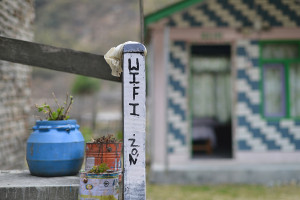Columns
Realising the Paris promise
The success of COP30 will be measured by results, not rhetoric.
Nirajan Dhungana
When the leaders of the world gather in Belém, Brazil, between November 10 to 21 for the 30th United Nations Climate Change Conference (COP30), one determinative question will confront them: Can humanity still preserve the 1.5 degrees Celsius goal? The answer will not be delivered by eloquent orations but by whether governments and industries can turn promises into concrete energy infrastructure, financial products and fair green-economy shifts. The Paris Agreement provided us with the blueprint and the 2023 Global Stocktake revealed the ambition-action gap. COP30 must be the tipping point where finance, technology and governance align to deliver concrete climate results.
At the centre of it is the energy-system transition. Energy consumption is responsible for nearly three-quarters of global greenhouse gas emissions. Decarbonising it offers the fastest and most affordable way to a stabilised temperature. The International Energy Agency puts the overall renewable capacity at needing to triple by 2030 if the world is to stay on track to hit 1.5 degrees Celsius. It requires action-for-results, especially optimising hydroelectric power using new technologies such as variable-speed pumped-storage hydropower.
Nepal, lying between two economic giants, China and India, is both a source of gigantic potential and a persistent paradox. Nepal boasts a theoretical hydropower potential of around 150,000 MW if harnessed through advanced technologies satisfying Q20 or Q25 environmental flow provisions. However, by 2024, Nepal had reached only some 3,500 MW, with proposals to utilise just 42,000 MW, short of one-third of its total potential. This vast unexploited potential is not only a national shortfall but a broader global phenomenon of wasted green-energy potential driven by limited strategic vision, flawed investment frameworks and weak cross-border co-ordination, as well as exploitation of the planet and a threat to humanity.
It can also be an opportunity for the whole of Asia and the world, as it allows low-cost energy endowment with a cost as low as $2-3 per kilogram, which further underscores the transformative potential. The resulting "loss" of clean power potential in Nepal is symptomatic of how the world continues to exhaust the planet's ecological balance and the very underpinnings of life through the lack of action.
The COP30 must create a tangible agenda for maximising hydropower production fuelled by added solar and wind capacity and upgrading regional transmission "silk grids." Only by delivering such possibilities to real implementation can the world be turned into a healthy and resilient place for future generations, thereby making hydropower a pillar of climate resilience and sustainable development. From Latin America to East Asia, and from South and Southeast Asia to Africa, a unified, visionary effort from 2026 to 2030 is needed to build strong renewable systems and interconnect them with high-capacity cross-border grids. In the case of hydropower, welcoming high-efficiency technologies such as variable-speed pumped-storage is the key. Regional vision is one: Retrofit ageing dams, introduce pumped-storage to reconcile variable renewables and construct transnational "silk grids" for electricity trade.
In Africa, greater hydropower and pumped storage and enhanced West-East-South grid interconnections might unleash vast clean-energy flows. In Latin America, the Andes and Amazon basins can be hubs for north–south transmission corridors. East Asia can create ultra-high-voltage (UHV) grids connecting China, Mongolia, Korea and Japan, supported by massive pumped-storage installations. South and Southeast Asia have the potential to open up projects in Nepal, Bhutan, Laos, India and Indonesia, and link them into the Association of Southeast Asian Nations (ASEAN) Power Grid and beyond. With complementary action, like 1,500 GW of global battery storage and electrification of transport, industry and homes, emissions will be lowered, energy security will be enhanced and millions of green jobs will be created, making the transition an engine of development. Governance and finance will ensure it.
All big grid and hydropower developments have to employ blended finance to reduce risk and accelerate delivery, with regional frameworks needing to coordinate trade, reliability, and maintenance standards. By 2030, if the world adds 45–50 GW of new sustainable hydropower and storage, builds 30 GW of new cross-border capacity, and adds 300 TWh more clean dispatch annually, displacing around 250 million tons of CO₂ annually, COP30's 1.5 degrees Celsius target can be achieved. Funding the transition is crucial.
The proposed "Baku-to-Belém Roadmap" seeks to mobilise over USD1.3 trillion a year by 2035, but quality and access count as much as quantity. Instruments such as adaptation grants and loss-and-damage, sovereign climate insurance and de-risking tools for private renewables can help translate pledges into pipelines. Blended finance, which brings together public, private, and philanthropic capital, can target high-impact but risk-perceived sectors such as distributed energy and climate-resilient infrastructure. Multilateral development banks must balance portfolios with 1.5 degrees Celsius pathways, expand local-currency lending, and redesign credit-rating systems to mobilise private investment. Adaptation must occur in tandem with mitigation. Mountain environments, the Himalayas to the Andes, are heating about twice as fast as the global average. The Global Goal on Adaptation must include indicators specific to mountains, such as glacier mass balance, cryosphere stability, and high-altitude livelihood resilience. Targeting "invisible infrastructure" such as meteorological networks, watershed management, and community insurance has big social and economic returns.
The green transition is similarly technology, industry, and human capital-founded. It can accelerate decarbonisation and distribute benefits more broadly by supporting deepened renewable supply chains, technical training and research collaborations. Normalised standards for hydrogen, batteries, and smart grids will save even more money and enhance interoperability.
There is governance and trust behind all advances. Open monitoring, reportable reporting and enshrining climate objectives within countries' laws convert pledges into outcomes. Alliances between developing countries, city networks, and private-sector partnerships can frequently marshal innovation more quickly than conventional negotiations.
The Global South, and China specifically, will be the determining factor. China's leadership in renewables has reduced technology costs globally by half, and its Green Belt and Road Initiative can spur low-carbon infrastructure across Asia, Africa, and Latin America. Reoriented to nature-positive and climate-resilient development, these initiatives could catalyse mutual prosperity as they support global emission-reduction ambitions.
In the end, the success of COP30 will be measured by results, not rhetoric.
The summit must offer more concise short-term commitments, honest finance, standards of integrity, and mountain-inclusive adaptation targets. The 1.5 degrees Celsius trajectory relies on introducing green energy as the driver and the green economy as the vehicle. If COP30 can bring finance, technology, and governance under one vision of inclusion and accountability, humankind can still bend emissions while building growth, equity, and ecological harmony. Belém offers a generation-defining opportunity to translate commitments into action—to merge mitigation with adaptation, energy with nature, and build an economically inclusive world green economy that leaves no country or mountain behind.




 11.12°C Kathmandu
11.12°C Kathmandu













%20(1).jpg&w=300&height=200)

